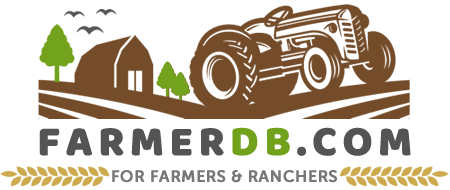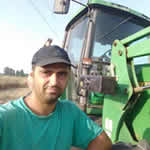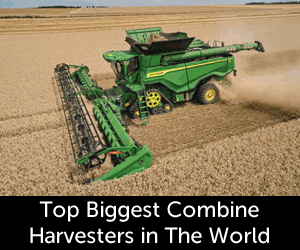Salers cattle are a dual-purpose breed and are also known as one of the oldest and most genetically pure cattle breeds in Europe.
Originating from Cantal, in the Massif Central of France, their history dates back around 7,000 years. Archaeologists discovered ancient cave drawings near Salers, a small medieval town in central France, that show cattle resembling the modern Salers breed.
This breed was also one of the last European cattle to be imported into North America. The first Salers arrived there in 1972, followed by the first exports to American soil in 1975, which included one bull and four heifers.
Between 1975 and 1978, a total of 52 heifers and six bulls were brought to the United States, while more than 100 made their way to Canada.
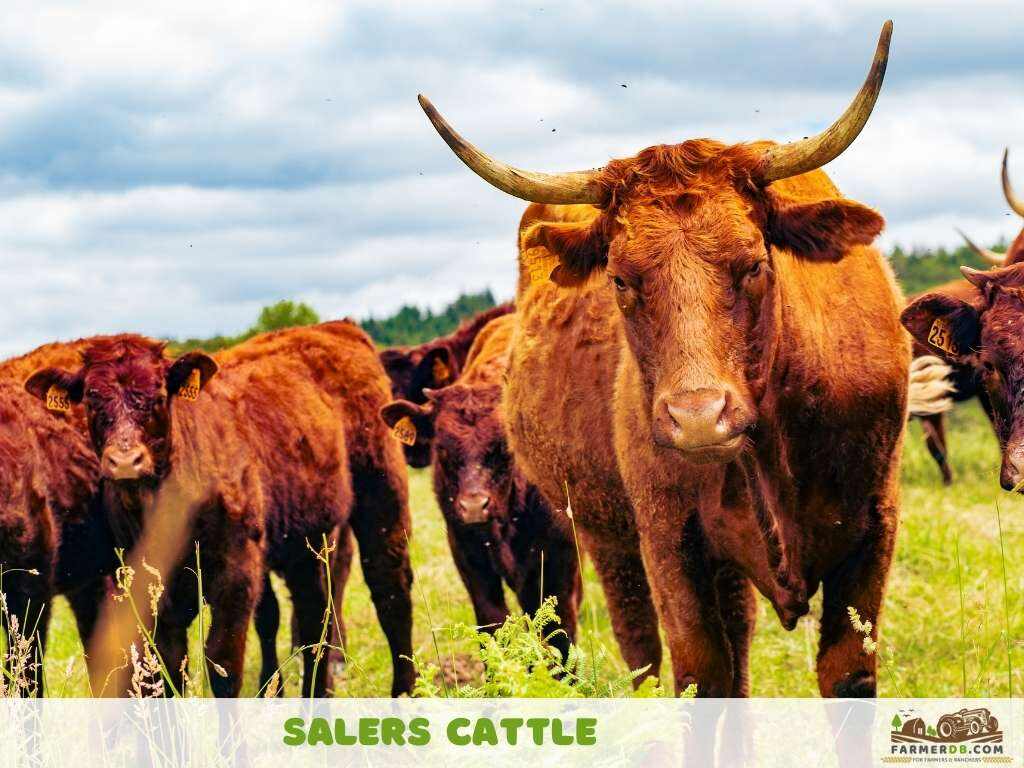
The Salers breed continues to grow year after year, becoming one of the favorite choices among farmers and crossbreeding programs.
Contents
Characteristics
Color
These cattle, especially the traditional ones, have a dark red color, but some modern ones can be black. Most Salers have no white markings, and their color is even all over the body.
Head
These cattle have a broad but well-shaped head and a large, curved forehead. Their eyes are dark and alert, with pigmentation around them that helps protect them from the sun and eye diseases. The jaw is strong, and the muzzle is wide with a lighter color, usually pink or creamy white.
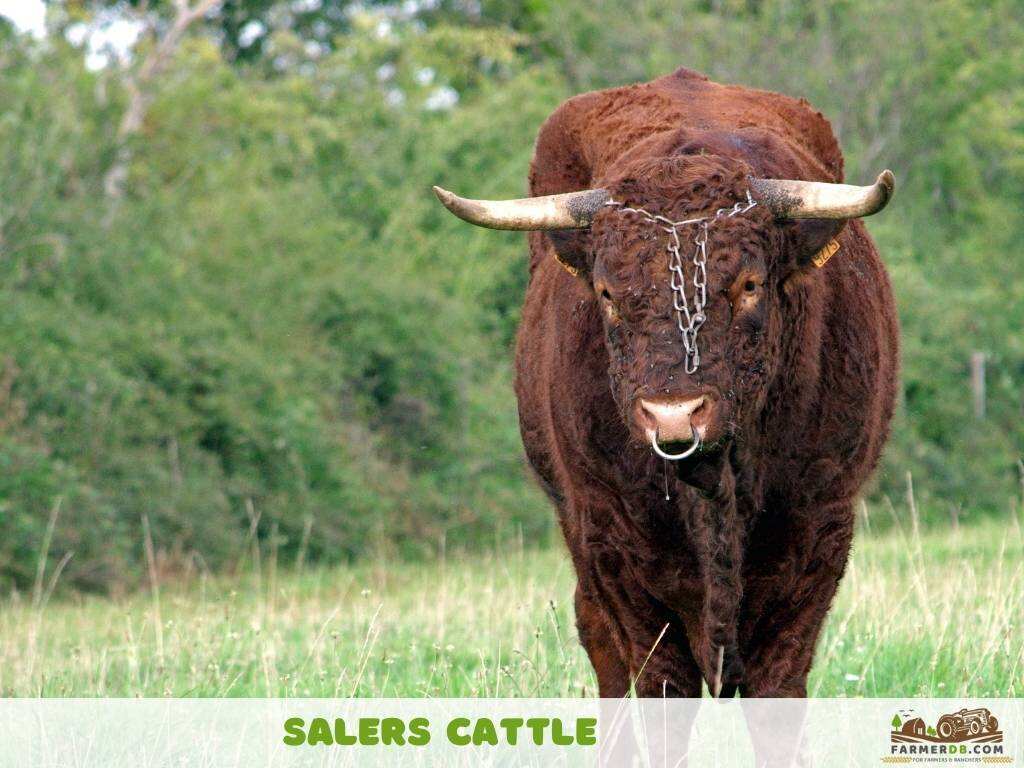
Horns
Traditional Salers cattle have long, curved horns that are light-colored with darker tips. Their horns grow outward and then curve upward. Nowadays, polled cattle also exist, as they have been selectively bred to not grow horns.
Body
Their body is strong with well-defined muscles.
The neck is medium in length, and the shoulders, like the rest of the body, are well-muscled but not too bulky. They have a straight and level topline, and the rump is wide and well-shaped.
Their ribs are well-sprung, giving them a deep and broad chest, and lastly, the loin is long and robust.
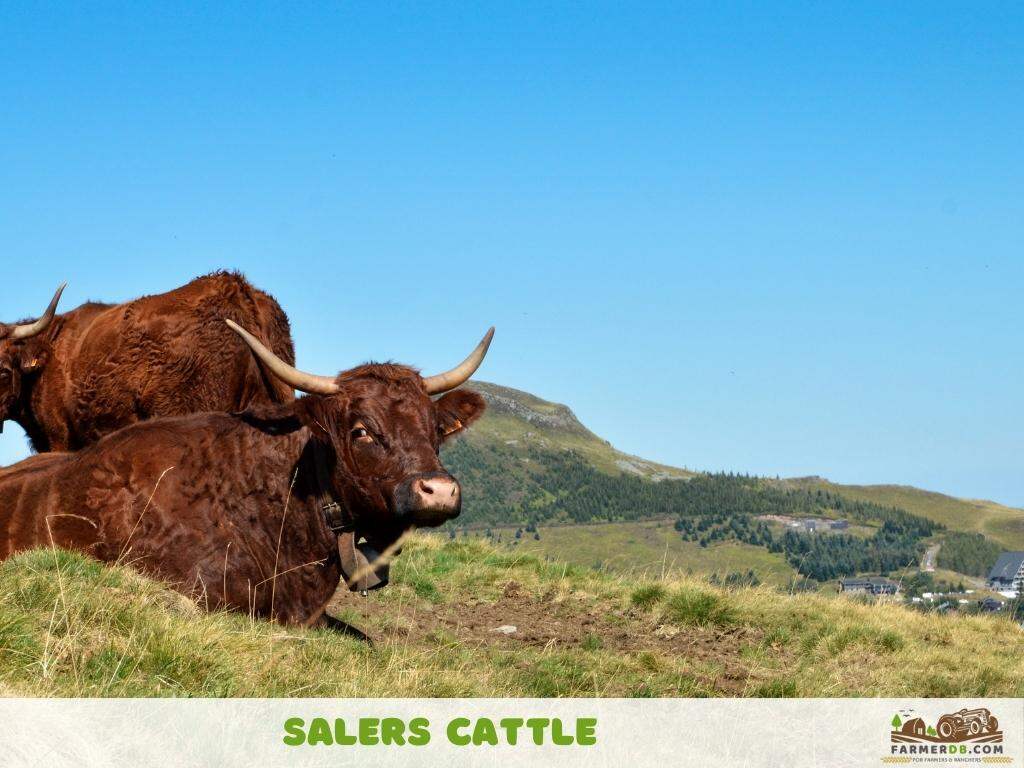
Legs
They have long, correctly structured legs, and their hard black hooves are highly durable. The deep heel provides good support and balance.
Udder and Teats
The udder is properly developed with good attachment and a medium size. The teats are medium-sized and evenly spaced, making them easy to use.
Size
This breed is classified as medium to large-sized.
Cows typically stand 4.6 ft (1.40 m) tall, and bulls grow to 5 ft (1.54 m) at the withers.
Lifespan
This breed has good longevity, not too short but also not as long as Galloway or Dexter. They live for 10 to 15 years, according to data.
In France, around 13% of producing Salers cows are over 10 years old.
This moderate lifespan is appreciated by farmers, as it makes them easier to raise with fewer replacements needed.
Growth Rate
How fast do they grow?
These cattle grow efficiently, with bull calves averaging 2.2 to 2.4 lbs (1,000 to 1,100 g) per day and heifer calves gaining around 2.0 to 2.2 lbs (900 to 1,000 g) daily.
Their strong growth performance results in weaning weights of at least 705 lbs (320 kg) for bulls and 660 lbs (300 kg) for heifers, without the need for additional feeding.
Weight
Adult Salers cows weigh about 1,430 to 1,870 lbs (650-850 kg), while bulls can weigh 2,200 to 2,650 lbs (1,000-1,200 kg). Newborn Salers calves are light at birth, weighing about 79 lbs (36 kg) for heifers and 84 lbs (38 kg) for bulls. They are also long and rather flat in shape.
During the Paris Show, some Salers cattle were measured and presented, with notable weights recorded. However, in the UK, even more impressive weights have been documented, highlighting the breed’s exceptional growth potential and adaptability.
| Category | Weight |
|---|---|
| Average weight of cows (5 years+) | 1860.7 lbs (844 kg) |
| Average weight of bulls (4 years+) | 2665.39 lbs (1209 kg) |
| Heaviest weight of cow | 2123.05 lbs (963 kg) |
| Heaviest weight of bull | 3088.67 lbs (1401 kg) |
Slaughtered Time
Salers cattle reach slaughter weight between 10 and 16 months, producing high-quality, lean carcasses that meet industry standards, with a carcass yield of around 60%.
Their competitive live weight gains and efficient feed conversion make them a profitable choice for beef production.
It is also important to note that this breed is commonly used in crossbreeding programs to increase meat yield, as their carcasses provide more pounds of saleable red meat than almost any other breed.
They are longer, heavier, and thicker than Angus, Hereford, and Red Angus.
Temperament
The temperament of Salers cattle is both strong and manageable.
They are watchful, smart, and capable of adapting to different surroundings. Though they may show protective instincts, especially as mothers, they remain cooperative and easy to handle with the right care.
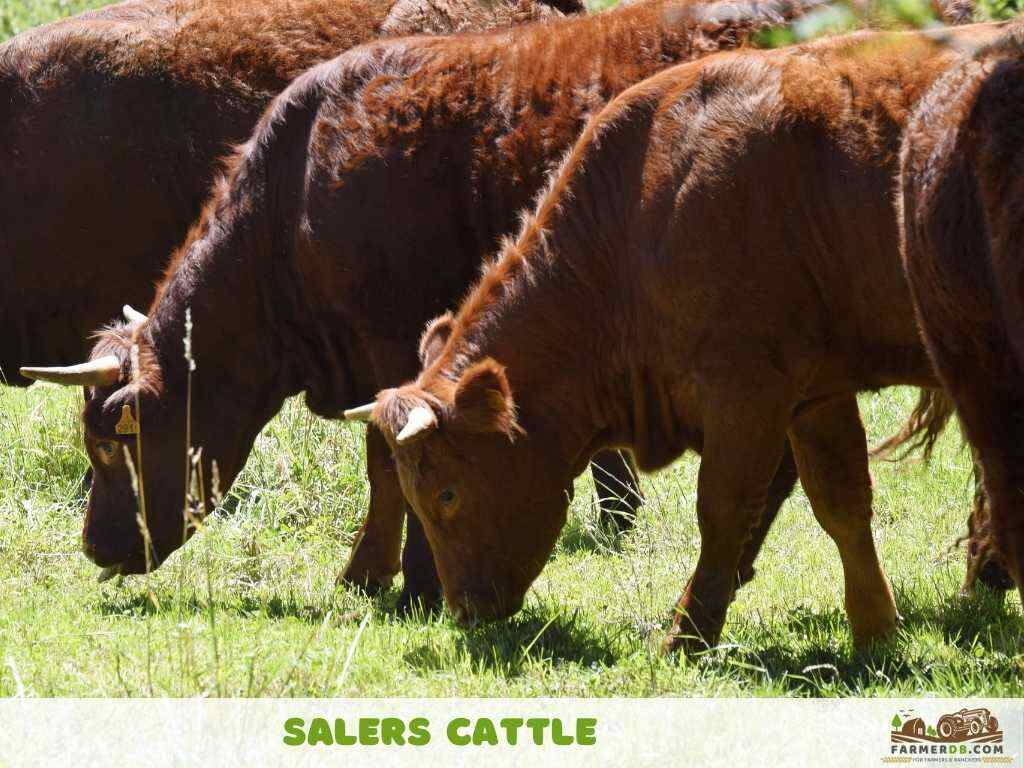
They are also social animals, interacting well with both other livestock and people. Their love for grazing and preference for herd life make them better suited to open pasture systems rather than isolation.
Be careful, as some individuals, especially bulls during breeding, may become aggressive, more alert, or active, requiring careful management.
Meat
The meat of these cattle is not as luxurious as Wagyu meat, but it has the qualities to be classified as high-quality beef.
It has a dark red color and is lean and tender, yet it also contains a good amount of marbling, which helps it retain its juiciness and rich taste after cooking. It is also high in omega-3 and omega-6 fatty acids, along with essential vitamins like B12 and minerals such as zinc.
Milk
These cattle can produce a decent amount of milk, even though they are more valued in the beef industry.
Less than 10% of all Salers cattle are primarily used for dairy production, while the majority (over 90%) are bred and raised for beef production. This small percentage of dairy-type Salers comes from lines historically selected for higher milk production, often used in traditional cheese-making.
Unlike many other dairy breeds, Salers cows often need their calf nearby to begin milking sessions. This trait reflects their strong maternal instinct and their natural way of nurturing.
A milking Salers cow can produce up to 793 gallons (3,000 liters) of milk per year, with a daily average of about 2.93 gallons (11.1 liters) over a 274-day lactation period.
Their milk has a higher fat percentage and is used to make traditional cheeses, including Appellation d’Origine Contrôlée (AOC) cheeses like Cantal, Salers, and AOC Fin Gras du Mézenc.
Raising
Feeding
When raising Salers cattle, it is important to provide them with a forage-rich diet.
During warm seasons, they should have access to fresh grass, while in colder months, they need hay. These cattle are very good grazers, and in some countries, like France, they are raised only on grass and forage, without any extra feed.
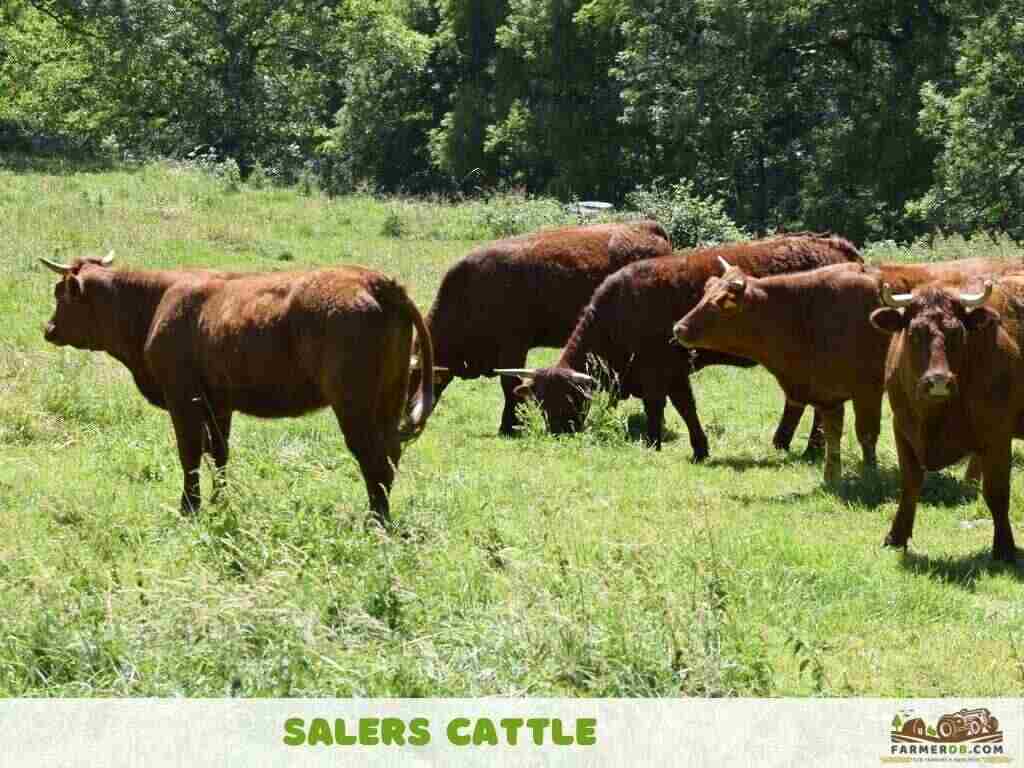
They can also survive on lower-quality pastures because they have a good ability to convert feed efficiently. This does not mean that you cannot give them grains if needed. Grains can help them gain weight faster or provide extra energy during important periods like lactation or finishing.
Many farmers choose to raise Salers cattle only on high-quality forage, as they can reach production goals without needing extra feed.
Whether in harsh winters or hot summers, these cattle perform well on forage-based diets and remain strong and productive.
Environment, Climate, and Shelter
Salers cattle can grow in extensive farming systems, as they are hardy and well-adapted to grazing-based production. They do well in rugged terrain, mountain regions, and open pastures, where they can survive on forage alone.
They also adapt to different climates, from cold winters to hot summers, thanks to their thick coat and strong build. Their resilience to harsh weather makes them a great choice for farmers in various environments where other breeds might struggle.
How many cattle per acre?
For one cattle, you need 1.5 to 2 acres per animal, as they are used to eating less compared to other cattle of the same size while still maintaining good weight.
Only in extreme pasture shortage conditions might you need 3 to 3.5 acres per animal, but it’s always best to keep track of their weight and condition and make adjustments as needed.
Breeding
Heifers reach puberty at 12 months old, but it is best to wait until 15 to 16 months before their first breeding so they can have their first calf at 2 years old. Bulls reach puberty at the same age as heifers, but their peak breeding performance is around 36 months old.
This breed has strong fertility, and a single bull can breed up to 70-80 cows at once.
If needed, here is a Cattle Gestation Calculator & Calendar
The gestation period for these cattle is around 280 days.
One of the breed’s biggest advantages is its easy calving.
Salers calves are born vigorous and lightweight. Their long and flat body shape allows them to pass through the birth canal more easily, lowering the risk of calving difficulties.
Another factor that helps with calving is the cow’s pelvic structure, which is much larger than in other breeds. Salers bulls are popular for crossbreeding with both commercial and dairy heifers, as they pass on a large pelvic area to crossbred females.
Cows are good mothers and provide a good amount of milk to their calves. During difficult periods, they rely on their body reserves to keep producing milk for their calves. When better feeding conditions return, they quickly regain their strength. This adaptability, known as the “concertina effect“, allows them to handle feed shortages better than many other breeds.
Bulls of this breed are known for their hybrid vigor and are often used in crossbreeding programs to increase red meat yield, improve marbling, and maintain strong maternal and reproductive performance.
Salers x Angus, Salers x Charolais, and Salers x Simmental are some of the most preferred crossbreeding combinations among farmers.
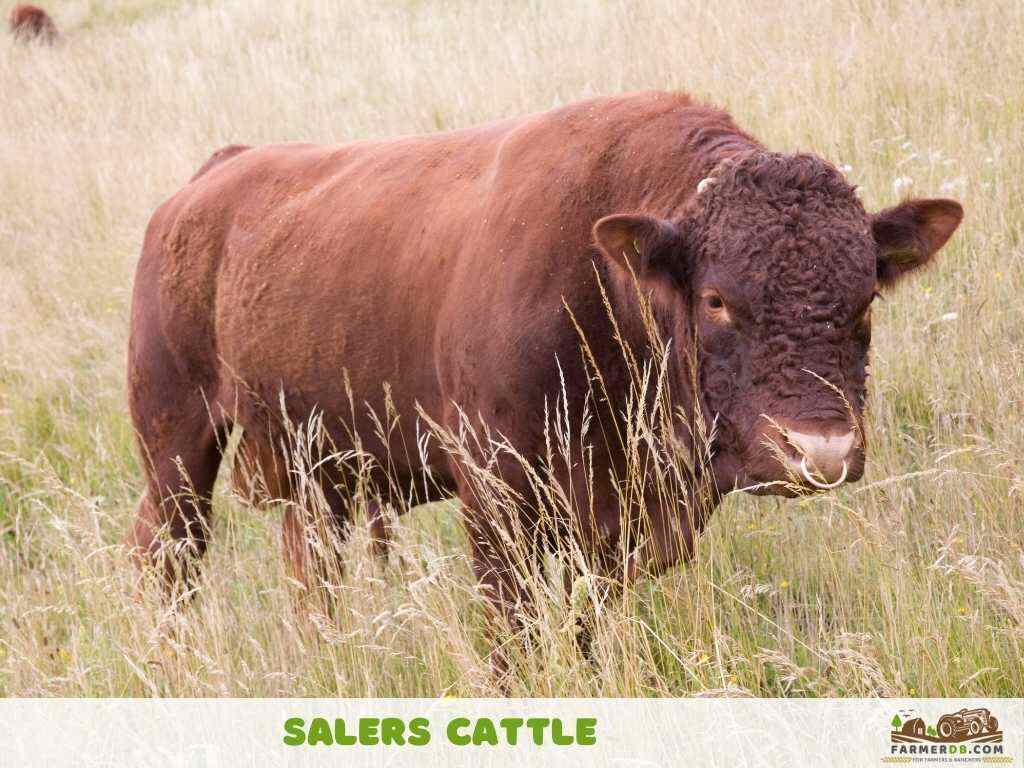
Terminal vs. Maternal
With a strong reputation as a top maternal breed, these cattle perform well in suckler herds, providing good fertility, easy calving, and high milk production. Their natural mothering ability helps farmers raise healthy replacement heifers and maintain productive maternal lines.
Health Issues
These cattle are tough and have strong natural resistance to diseases. Half-blood to full-blood Salers cows experience almost no calving problems, and cases of prolapse, pinkeye, or foot rot are extremely rare.
Registration
When registering Salers cattle, breeders must follow certain rules, including AI and genetic testing.
If a calf is conceived through artificial insemination (AI), the registration must include AI certificates as proof.
Genetic testing is also important, especially for the myostatin gene. Some mutations of this gene can affect muscle growth, calving ease, and fertility. To be registered, Salers cattle must be tested to confirm their myostatin status, ensuring they do not carry unwanted mutations.
For embryo transfers, both the donor cow and sire must be genetically tested, and proper documentation must be provided.
This helps maintain the breed’s quality and ensures that all registered animals meet the required standards.
Why should you raise it
This breed is highly reliable, making it a good cattle for small farms or homesteaders with very few reasons not to raise it.
Their natural disease resistance, easy calving without prolapses, assistance, or C-sections, and strong feed conversion make them cost-effective cattle that require less money and effort compared to other breeds.
They cover more ground and utilize pasture better than most breeds, improving range and pasture management and making them ideal for extensive grazing systems.
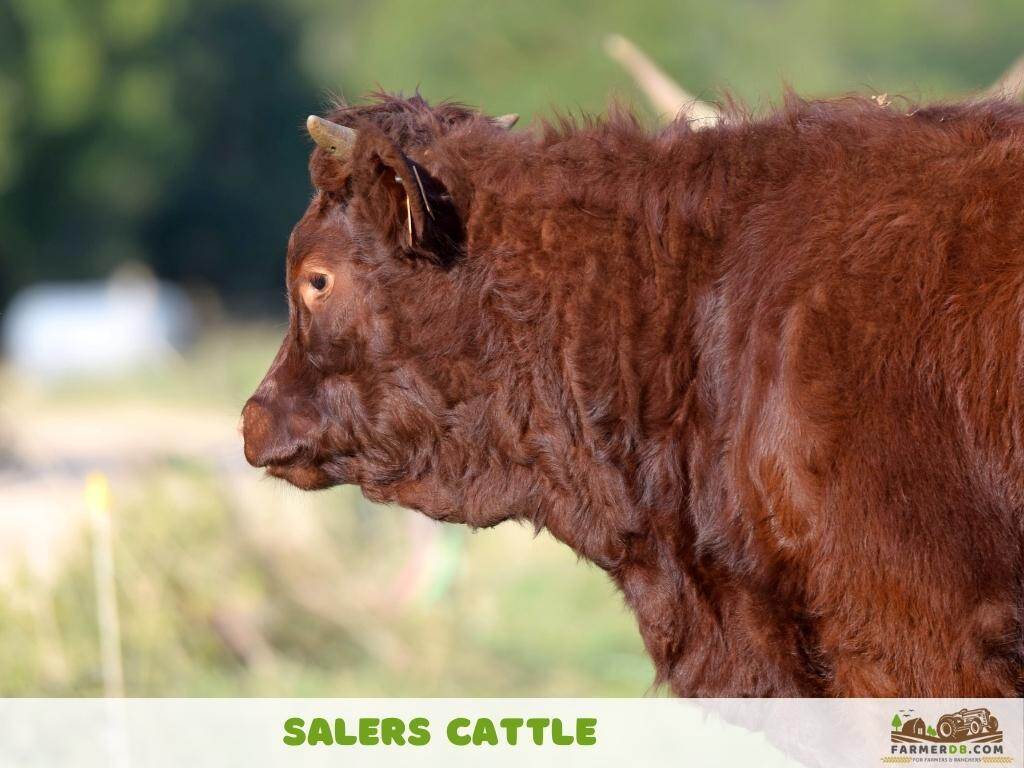
Their carcass can easily outperform breeds like Angus in weight, feed conversion, and overall health, while their ability to adapt to temperatures from +30°C to -20°C makes them a reliable choice in various climates.
Using Salers bulls for crossbreeding enhances hybrid vigor, boosting efficiency in other breeds by up to 15%, lowering disease risk and antibiotic use, and producing healthier cattle.
These are just some of the reasons to raise Salers cattle.
Advantages
- Good size
- Easy calving
- Great maternal traits
- Efficient forage utilization
- Longevity and hardiness
- Hybrid vigor in crossbreeding
- Disease resistance
- Good carcass size
- High dressing percentage
- High fat milk
Disadvantages
- Protective mothers
- Need for proper handling during breeding
- Longer maturity for bulls
- Lower marbling than some breeds
- AI and genetic testing requirements for registration
- Not the fastest finishing breed
References
Do you have any experience with the topic discussed here?
Would you like to improve the information shared and contribute your practical knowledge on the subject?
Your real-world experience as a farmer or rancher could greatly benefit other members, and the community would deeply appreciate your contribution.
